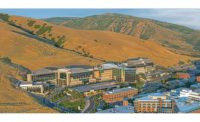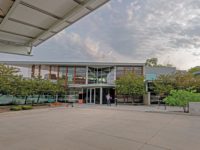At a time when many firms are in survival mode, trimming costs and eliminating risk, Architectural Nexus is thriving, and it�s encouraging employees to pursue work they�re passionate about, even if it�s not a fi rm specialty.
Formed in 2003 by the merger of Jensen Haslem Architects and Thomas Petersen Hammond Architects, Architectural Nexus now has 100 employees among offi ces in Logan, Utah; and Tempe, Ariz.; and a new LEED-Platinum Salt Lake City headquarters, an energetic design studio coaxed from a bland fi tness facility.
President Donald Finlayson, who joined Jensen Haslem as a health-care specialist in 1996, became Architectural Nexus� president immediately after the merger.
From the start, Finlayson has fostered a culture of respect for individual talents and passions that now defi nes the firm.
“During my entire career of working in larger firms, my perspective was that principals were competitive with each other, and opportunities were missed as a result. I have tried to create a thriving culture. There�s a lot I don�t know, so I bring diverse talent together and we all give input,” he says.
Embracing Diversity
Being open to new viewpoints and interests has served the company well. At one of the firm�s semiannual leadership retreats attended by about 30 people, Finlayson recalls, �It was a bunch of old guys headed in a direction�mostly toward retirement�and a bunch of young people, glad to have a job but not necessarily doing what they were interested in.
“We went around the room and asked every person what they wanted to do, and it didn�t have to be related to what Tom or Don or whoever wanted.”
He says people spoke up, sometimes stating an interest in a sector new to the firm. In many cases, it would�ve ended there, but not at Architectural Nexus. People tracked down and won the work, put teams together and completed projects.
“It became something that has carried us through the recession� this diversity�created by people exploring their own passion,” Finlayson adds.
Architectural Nexus� founders looked at the merger itself as an opportunity to diversify. “We knew there were strengths to be captured when the two fi rms were contemplating merging,” says principal Tim Thomas. “We formed a team for a project at the Emma Eccles Jones Medical Science Building at the University of Utah, and the outcome of the collaboration was compelling to the point that it was obvious working together was benefi cial to both firms.”
Building a Neighborhood
Architectural Nexus primarily serves large institutional clients, including academic campuses, civic and municipal agencies, healthcare systems, research laboratories and mixed-use and resort properties. Most of the firm�s work is in the Intermountain West, with a few projects sprinkled across the globe.
Notable recent projects include the Huntsman Cancer Institute Research Hospital at the University of Utah in Salt Lake City; West Side Development at Hill Air Force Base in Clearfi eld, Utah; the Biomedical Polymers Research Facility at University of Utah; Cache County Administration Building in Logan; and multiple projects, including temples, for the LDS Church.
Founding principal Tom Jensen says that such high-profile projects would hardly have seemed possible in the earliest days. He says that in 1980, when he co-founded Jensen Haslem (with Bruce Haslem) in Logan, “We were pretty humble. If we could do a couple projects a year, we thought that would be great. But we just kept going.”
As Architectural Nexus has “kept going,” it preserves its culture while adding personnel. To lessen the burden on management and allow more focus on individual needs and skills, the fi rm has created six “neighborhoods” of employees. Within this system, people are allowed to pursue work that matters to them.
|
Architectural Nexus � Huntsman Cancer Institute Salt Lake City � Huntsman Cancer Hospital Salt Lake City � University Hospital Eccles Critical Care Pavilion Salt Lake City � University Hospital West Pavilion Salt Lake City � University Park Hotel, Research Park Salt Lake City � Myriad Genetics, Research Park Salt Lake City |
Principal Kenner Kingston, part of a corps of young leaders, says, “It�s about problem-solving and it�s about passion. You need people that enjoy the work. It�s collaborative, and people just turn on. It could be misinterpreted as workaholic, but it�s not that.”
Peer and principal Scott Larkin agrees. “Because we�re passionate about what we do, we feel we can accomplish it within reasonable hours. It seems crazy to newcomers that you can be a principal without working 70 hours a week.”
Role Playing
Architectural Nexus widely distributes task ownership and management by tapping employees as leaders in rotating roles. For example, some people direct marketing efforts for a couple of years, which provides de facto, on-the-job training.
The firm also has developed a project-team structure that includes several principals on each job contributing technical expertise. One of those project principals�often selected because of an existing client relationship�additionally takes on the role of principal-in-charge, handling overall coordination and relationship management.
Finlayson calls this “almost a matrix approach,” and says that no one is envious of other people�s clients, workloads or roles. “The reason we actually like each other is because we contribute to each other�s success.”
“The firm culture is future-thinking,” Larkin says. “It�s far-sighted to be willing to offer such meaningful opportunities to young people.” He says management believes that by teaching people to lead early in their careers, “you�ll really be able to do something.”
He adds that through the fi rm�s commitment to mentoring, “I make people around me great.”
Mentoring Design
The firm�s design process, overseen by design director David Cassil, also is shaped by ideals of shared responsibility and mentoring. “We say, �Let the best idea win,” Cassil says. “I keep focused on that. I�ve grown from a hands-on designer to a mentor. I try to paint a picture in the designer�s mind, to sum up the client for them, to help them understand the design goals.”
Jensen adds, “This firm is based on the idea of a collaborative, not the idea of a hero or a name at the top. When somebody calls, we put together a team with all the skills they need.”
For the future, Cassil says the firm needs “to keep centered on what is important: creating places for people to commune, congregate and live. Architects who don�t keep their arms around these concepts don�t grasp what we really do. All the greatest technology or sustainability, they don�t make a project great. What makes a project great is the light streaming in, is making people feel like they want to be there.”
Kingston adds: “The best days are yet to come. The great thing is we haven�t hit our prime yet. As I look at people coming up through management, the potential is so exciting. The sky is the limit.”








